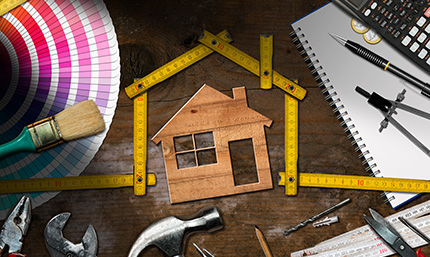News & Tips
How Mortgage Refinancing Works (+The Best Time to Do It)

Refinancing your mortgage can help you save money with a lower interest rate and get you to the home ownership finish line faster than your current one. Or, it could be a good way for you to cash out on some of your home’s equity for other projects. To determine if it’s the right path for your goals, it’s best to understand how mortgage refinancing works more in depth. We at Space Coast Credit Union are happy to help you weigh all of its pros and cons and walk you through the steps.
What is Mortgage Refinancing?
With mortgage refinancing, you’re replacing your existing mortgage with a new one. Some people stick with the same lender or go with a different one — depending on who offers better rates, lower closing costs or fees, deals, and sometimes, customer service. But in most cases, people refinance their mortgage to enjoy all of the benefits of a lower interest rate.
Example of how mortgage refinancing works: Let’s say you owe $160,000 on your home. You then find a new lender who can give you a loan for that same amount at a lower interest rate. After you’ve gone through the application and approval process, the new lender will pay off your old lender. You now owe your new lender $160,000. This time, you’ll likely save more money over the remaining life of your loan.
Keep in mind you may still have to pay closing costs and other fees like you did with your original mortgage. That’s why it’s a good idea to shop around for lenders that will waive some of those costs. Ultimately, if your goal is to save more money, it’s best to do the calculations to check that the total cost of refinancing will be lower than sticking with your current loan.
The three main types of mortgage refinancing include:
- Rate-and-term refinance: As the name implies, this type of loan is usually about getting a lower interest rate or changing the length of the loan (or both). In most cases, people are looking to save money with this option.
- Cash-out refinance: This is when homeowners want to cash out on some of their home’s equity. You’ll refinance the remaining loan balance, plus the additional amount of cash you want to take out, resulting in a new loan amount that’s bigger.
- Cash-in refinance: With this type, people bring money to the lender to lower their loan-to-value ratio (LTV), so they can get a lower interest rate or shorten the loan term (or both). Usually, people want to pay the loan down to 80% LTV or lower, so that they can get their mortgage insurance premium (MIP) cancelled while refinancing.
Pros and Cons of Refinancing a Mortgage
Most experts recommend refinancing a mortgage if you can lower your current interest rate by at least 0.75 to 1 percent. Also, it’s a good idea not to plan to move any time soon after refinancing to “break even” from closing costs. A refinancing mortgage calculator can be a helpful way to plug in the numbers and see if a new loan will be worth it for you. Or, you’re more than welcome to talk to one of our mortgage experts to help you do some calculations. Give us a call at 800-447-7228, ext. 8976.
Pros:
- Saving more money with a lower interest rate: If your financial profile has improved—namely your credit score and payment history—then you’re more likely to get a lower interest rate. Lower interest rates often mean you’ll build more equity at a faster rate and pay less over the life of the loan. SCCU offers competitive refinancing mortgage rates.
- Tapping into your home’s equity: Homeowners can do this when the value of their home exceeds the amount owed on the mortgage. This may happen because you’ve made significant payments to your principal, or because home values have increased, or both. This money can come in handy to pay off debts with high-interest rates, pay for home improvements or college tuition, and other large expenses while getting a lower interest rate on their new mortgage loan.
- Swapping out the type of interest rate: Changing from an adjustable interest rate to a fixed-interest rate can offer more stability, especially with budgeting for long-term costs. Or, switching from a fixed-rate to an adjustable rate means lower monthly payments initially.
- Removing FHA mortgage insurance premiums: If you’re not planning to sell your home anytime soon and have enough equity, you can often remove the FHA premiums by refinancing the loan.
Cons:
- Paying for closing costs: Unfortunately, with most refinances you’ll need to factor in the closing costs like you paid with your first home loan. These costs are usually 2 percent to 6 percent of the new loan amount and involve origination fees, appraisal fee, title insurance fee, credit report fee, and more. You may be able to find a lender that will discount or waive some or all of these fees.
- Dealing with cash-out downsides: Cashing out on your home’s equity usually means a higher loan amount and possibly higher monthly payments.
- Experiencing a long refinancing process: The average refinance process timeline is 50 to 60 days, depending on the type of loan. It can also take longer if a lot of homeowners are looking to refinance at the same time to benefit from lower interest rates.
- Affecting your credit: Unfortunately, your credit can take a hard hit when you’re applying for a mortgage loan. It can even drop a few points. But several similar inquiries within a short time period usually only count as one inquiry. If you’re shopping around for the best rates, it’s a good idea to reach out only to your A-list of lenders in that short time span.
Steps to Refinance Your Mortgage
- Determine if refinancing makes financial sense for you. First, it’s a good idea to ensure that mortgage refinancing will meet your primary goals without costing you more in the long run to go with a new loan versus staying with your current one. If you’re looking to shorten the term of your loan, factor in that you might need to adjust your budget for higher monthly payments. You’ll also need to check that you’ll meet the requirements to refinance your loan. In most cases, you’ll need to be under a certain debt-to-income ratio, have at least 20 percent equity in your home, and have a credit score at or above 620. As a member of SCCU, you can access your FICO score within Online Banking account for free.
- Shop around for the best rates and compare lenders. With your mortgage refinancing goals in mind, the next step is to explore your options. You can check with your current lender, banks and credit unions, non-bank lenders, and referrals from your network. Information overload? Filling out a spreadsheet with various lenders’ mortgage refinancing products and their interest rates, fees, terms, and requirements in columns side by side can help. Fortunately, some lenders may waive pre-payment penalties like we do at SCCU.
- Apply to refinance with your top choices. The next step is to start the application process. You’ll need to gather a portfolio of documentation for the lender to check that you meet their qualifications and determine your rate. Again, it’s best to stick with only a couple of lenders to minimize to the effects on your credit. You’ll most likely need to submit proof of income (W2s, tax returns, bank statements, paycheck stubs), proof of insurance, debt statements, and proof of assets. SCCU’s checklist with the paperwork you need can help. Each lender will give you a document with a Loan Estimate, which will give you an idea of the closing cost expenses.
- Lock in your interest rate. After your lender has approved you (congrats!), you can make a request to lock in a rate for that day’s options. However, the lender can only lock in the interest rate for a certain timeframe and work to close before the expiration date. This way, your lender will honor that rate even if the market rate rises during your mortgage refinancing process. Don’t worry, you’ll still have flexibility when it comes to selecting the type of loan and making changes to your application.
- Roll through the loan process. Like when you got your first mortgage for your home, you’ll need to get your home inspected, appraised, and title searched. The lender’s underwriting team will double-check everything and might reach out to you to ask questions or to request or verify additional documentation. They’ll scrutinize all the details to ensure that everything’s in order. The process can take a little while, but at least you won’t have to worry about the stress of moving.
- Close on the loan. Once the lender has finalized your loan, you’ll need to schedule a closing day with them. You’ll then need to submit any necessary documents, pay the closing costs, and sign the papers. And then it’s time to celebrate! You’ve made it through the mortgage refinancing process!
Why consider SCCU for mortgage refinancing?
The best time to refinance your mortgage ultimately depends on if it will help you accomplish your specific goals (while meeting the qualifications). SCCU offers a wide variety of mortgage loan options and competitive interest rates to help you. If you can’t decide which option will work best for you, we’re happy to help in any way we can.
And whether you’d prefer to apply online or over the phone, we’ll walk you through the whole process. Plus, we value your time and make quick approval decisions. The SCCU Member Service Center will be available for you during the life of the loan if you have any questions. Feel free to get in touch with us via the best method that suits your needs.
























.jpg?width=430&height=257&ext=.jpg)





